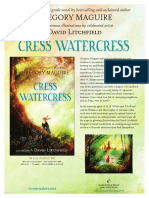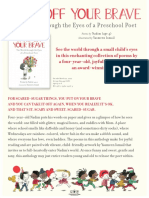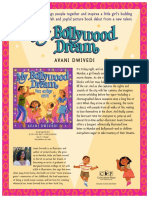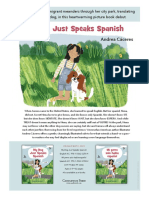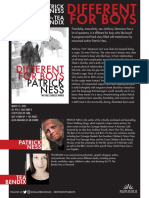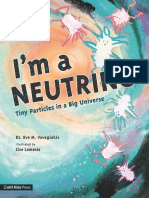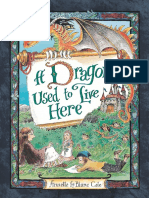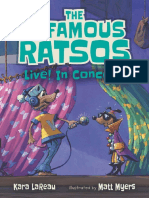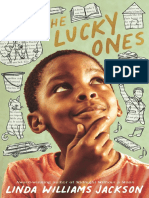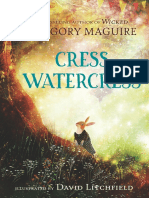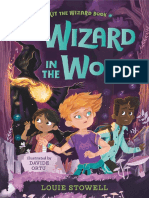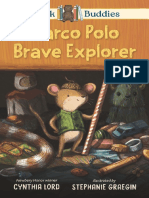Professional Documents
Culture Documents
Where The Water Takes Us by Alan Barillaro Press Release
Where The Water Takes Us by Alan Barillaro Press Release
Uploaded by
Candlewick PressOriginal Title
Copyright
Available Formats
Share this document
Did you find this document useful?
Is this content inappropriate?
Report this DocumentCopyright:
Available Formats
Where The Water Takes Us by Alan Barillaro Press Release
Where The Water Takes Us by Alan Barillaro Press Release
Uploaded by
Candlewick PressCopyright:
Available Formats
Debut author Alan Barillaro delivers a stirring story about a sensitive, shaken young girl who
must face that growing up means coming to terms with the things you cannot change—and
taking responsibility for the things you can.
WHERE THE WATER TAKES US
ALAN BARILLARO
Ava’s mom is about to have twins, and the pregnancy isn’t
going well. All Ava wants to do is stay by her mother’s side,
but instead she is sent away to stay with her grandparents.
Normally, spending time at the lakeside cabin with Nonna and
Nonno is wonderful, but everything is different now. While
her mom’s hospital visits are getting serious back home, Ava
grapples with anxiety. Summer storms rock the island, the
electricity goes out at the cabin, and an annoyingly cheerful boy
named Cody seems to pop up everywhere she goes, but Ava
can’t be distracted from the feeling that something terrible,
something irrevocable, is going to happen to her mom.
When a bird dies in front of her, Ava is sure it’s a sign that she
is cursed—the last thing she, or her family, needs. But if a curse
has been placed on her, there must be a way to break it. So Ava
makes a deal: if she can take care of two orphaned bird eggs, she
will have paid off her debt and her family will be all right.
With everyone she loves on the line, Ava will do everything in
her power to make sure that her mom, her twin baby brothers,
her birds, and even Cody all come through the summer safely.
Alan Barillaro is the Academy Award–winning writer
and director of the animated short film Piper and has been
On sale July 4, 2023
supervising animator on many other popular theatrical releases,
HC: 978-1-5362-2454-2
including The Incredibles, Incredibles 2, WALL-E, and Brave. He
$18.99 ($24.99 CAN)
Ages 8–12 • 208 pages
began his career in animation at the age of sixteen and spent
more than twenty-five years at Pixar Animation Studios. Alan
Barillaro lives in Canada.
Illustration copyright © 2023 by Alan Barillaro
Q & A with ALAN BARILLARO
Where the Water Takes Us is your publishing debut. Can you talk about what it’s
like to introduce new storytelling work in a different artistic medium for the very
first time? How does this experience differ from premiering a film, for example?
It’s freeing! I’d even go as far as to say necessary for me as an artist, especially when the shift
in medium has a positive impact on the story, which I believe is completely the case for Where the Water Takes Us. That’s always
the journey for me, trying to solve what path will allow me to create the best version of the story. It’s story first in my head, and
the rest of the time is honestly me just trying to dig myself out of the trouble I’ve gotten myself into.
As far as the differences in premiering the work, I’d say that film is much more a communal art form, as it’s often made with
hundreds of artists. When the lights go down at a film premiere, I find myself holding my breath, waiting for the audience’s
response. But it’s also everyone’s work up on the screen, so you can find support in that. Writing a novel completely exposes
you, which I’m not fully used to. There’s a vulnerability that seems necessary to writing—at least in my experience. My closest
comparison to this is as an animator/actor. You have to find a certain amount of vulnerability to play the moment honestly
and pull off a great performance, so I’ve tried to just accept that as a part of my writing process in hopes that it translates to
something that resonates with young readers.
The book deals with a specific but universal time in childhood when kids become increasingly more aware of the
worries and concerns of the adult world but aren’t quite ready emotionally to deal with the impact or have the
agency to change the outcome. How did you decide to play that conflict out so believably for Ava, and do you think
it’s a feeling young readers will really relate to as the story progresses?
The novels I loved growing up never trivialized a young person’s anxieties or avoided certain truths about life, so I lean in that
direction. Even if I wrote a fantastical story, I’d want to play out the underlying internal conflict with as much believability as
possible. That applies to everything in my work, whether I’m animating a clownfish who’s lost his son in Finding Nemo or I’m
writing a tender scene between Ava and Cody in Where the Water Takes Us—I want the audience/reader to care deeply for that
character.
Also, I have three young readers of my own, and they’re smart! I’ve seen them abandon a story if they sense a certain falseness
to the telling of it. I tried my best to be sensitive to that for this novel.
Two of the greatest strengths of the novel (there are many!) are the gorgeous imagery throughout and the sense of
place you create with your language. How does your experience as an animator inform your writing? Do you start
with an image?
I’ve been lucky over the last twenty-five years to be a more dramatic actor as far as the type of animated films I’ve been part of.
One of the things I’ve learned through that experience is that the real drama in a story is never the actual line but what’s behind
that line. It’s all in the subtext of the writing that’s beyond the surface of things. That certainly informs my approach as an
author, along with many other story lessons learned during my time at Pixar. Overall, I try not to ever fall in love with my own
text or illustrations. To me, that means you have to be willing to throw it all away for the sake of telling the best story. I try to
stay focused on that.
Also, I can’t ignore that each page of this novel is actually animated! The flip-book animation is composed of hand-painted
watercolors and is meant to echo what Ava and Cody go through together throughout the story. I’m excited for young readers
to stumble upon that. To me, that animation serves a specific story purpose. I hope it brings the story to life in the reader’s
imagination without getting in the way of how they might be imagining the world and the characters. It was always upsetting to
me as a young reader when I’d read a wonderful description of a character but feel the image told a different story altogether or
simply repeated the same information, or, worst of all, ruined my impression of something. I’ve always been inspired by E. H.
Illustration copyright © 2023 by Alan Barillaro
Shepard, illustrator of Winnie-the-Pooh, on how to handle illustrations and text. He always helped tell the story and knew just
what information to include and, more importantly, what not to include so that space was left for the reader’s imagination.
As far as starting with an image, I consciously avoided drawing in the earliest stages of this book, because truthfully, I just
couldn’t see how drawing the characters (for instance) was going to be helpful, and I didn’t want to repeat something the text
was already communicating. However, once the themes started to emerge, I started drawing and painting what I felt might
represent the tone and themes I was searching to express. It was the feeling of Ava being pulled away by a current (which is
really her anxieties) that I needed to express somehow and that led me down a specific path, artistically. I wanted the reader to
get pulled into the story as well, and this idea of a continuous line started to form in an attempt to represent that.
This is just the first of many writing projects in your creative pipeline. What is your biggest hope to achieve with
your storytelling for young people growing up today, in whatever form it takes for you?
There’s always a lot an artist can say about what they hope to achieve or try to communicate with their work! We’re
unfortunately at a very divisive time in our society. Young minds are attuned to that, whether we like it or not. My reaction is
to put forth stories where characters work hard to find how they connect with others in this world rather than selfishly conquer
that world. Nature, in my view, is a key to having a deeper understanding of ourselves as well as those around us. It teaches us
we are not so important as we might think and are not the center of the universe. Ultimately, it’s these connections that are
most interesting to me. Our connection with nature is our connection with one another. To me, they’re one and the same.
So a small preview of what’s to come from me is to say I will continue to explore these themes as best I can, but the way I achieve
that will be completely different from one book to the next. I hope that’s really exciting for young readers. They’ll never quite
know what form my next novel will take, but I hope they’re willing to give it a chance.
Illustrations copyright © 2023 by Alan Barillaro
You might also like
- Sari-Sari Summers by Lynnor Bontigao Press ReleaseDocument2 pagesSari-Sari Summers by Lynnor Bontigao Press ReleaseCandlewick PressNo ratings yet
- Anna Hibiscus by Atinuke Chapter SamplerDocument23 pagesAnna Hibiscus by Atinuke Chapter SamplerCandlewick Press100% (2)
- The Last Mapmaker Chapter SamplerDocument74 pagesThe Last Mapmaker Chapter SamplerCandlewick Press60% (5)
- OfftoclassDocument6 pagesOfftoclassapi-311051222No ratings yet
- Loki: A Bad God's Guide To Being Good by Louie Stowell Chapter SamplerDocument48 pagesLoki: A Bad God's Guide To Being Good by Louie Stowell Chapter SamplerCandlewick Press80% (5)
- Sanctuary: Kip Tiernan and Rosie's Place, The Nation's First Shelter For Women Press ReleaseDocument2 pagesSanctuary: Kip Tiernan and Rosie's Place, The Nation's First Shelter For Women Press ReleaseCandlewick PressNo ratings yet
- The Book That No One Wanted To Read by Richard Ayoade Press ReleaseDocument2 pagesThe Book That No One Wanted To Read by Richard Ayoade Press ReleaseCandlewick Press0% (1)
- Two-Headed Chicken by Tom Angleberger Author's NoteDocument1 pageTwo-Headed Chicken by Tom Angleberger Author's NoteCandlewick Press0% (1)
- The Hanmoji Handbook Your Guide To The Chinese Language Through Emoji Chapter SamplerDocument32 pagesThe Hanmoji Handbook Your Guide To The Chinese Language Through Emoji Chapter SamplerCandlewick Press100% (7)
- Become An App Inventor Chapter SamplerDocument45 pagesBecome An App Inventor Chapter SamplerCandlewick Press50% (2)
- Kids Fight Climate Change: Act Now To Be A #2minutesuperhero Chapter SamplerDocument26 pagesKids Fight Climate Change: Act Now To Be A #2minutesuperhero Chapter SamplerCandlewick Press100% (1)
- The Gifts That Bind Us by Caroline O'Donoghue Chapter SamplerDocument80 pagesThe Gifts That Bind Us by Caroline O'Donoghue Chapter SamplerCandlewick PressNo ratings yet
- Brand New Boy by David Almond Chapter SamplerDocument64 pagesBrand New Boy by David Almond Chapter SamplerCandlewick Press50% (2)
- Haven: A Small Cat's Big Adventure by Megan Wagner Lloyd Author's NoteDocument2 pagesHaven: A Small Cat's Big Adventure by Megan Wagner Lloyd Author's NoteCandlewick PressNo ratings yet
- 'Twas The Night Before Pride Press ReleaseDocument2 pages'Twas The Night Before Pride Press ReleaseCandlewick Press0% (2)
- Dasher Teacher Tip CardDocument2 pagesDasher Teacher Tip CardCandlewick PressNo ratings yet
- Space Taxi Common Core Educator GuideDocument2 pagesSpace Taxi Common Core Educator GuideLittle, Brown Books for Young ReadersNo ratings yet
- The Little Snowplow Wishes For Snow Activity KitDocument9 pagesThe Little Snowplow Wishes For Snow Activity KitCandlewick PressNo ratings yet
- LaststoponmarketstreetppDocument17 pagesLaststoponmarketstreetppapi-408212103No ratings yet
- I Am A Baby by Bob Shea Author's NoteDocument2 pagesI Am A Baby by Bob Shea Author's NoteCandlewick PressNo ratings yet
- Beverly, Right Here by Kate DiCamillo Discussion GuideDocument3 pagesBeverly, Right Here by Kate DiCamillo Discussion GuideCandlewick PressNo ratings yet
- Polo Cowboy Discussion GuideDocument3 pagesPolo Cowboy Discussion GuideCandlewick PressNo ratings yet
- The Waiting Place: When Home Is Lost and A New One Not Yet Found Press ReleaseDocument2 pagesThe Waiting Place: When Home Is Lost and A New One Not Yet Found Press ReleaseCandlewick PressNo ratings yet
- Ear Worm! by Jo Knowles Teacher Tip CardDocument2 pagesEar Worm! by Jo Knowles Teacher Tip CardCandlewick PressNo ratings yet
- Anna Hibiscus by Atinuke Press ReleaseDocument2 pagesAnna Hibiscus by Atinuke Press ReleaseCandlewick PressNo ratings yet
- Dragonfly Eyes by Cao Wenxuan Press ReleaseDocument2 pagesDragonfly Eyes by Cao Wenxuan Press ReleaseCandlewick PressNo ratings yet
- Read and Wonder: Combining Science and Story Candlewick Press BrochureDocument2 pagesRead and Wonder: Combining Science and Story Candlewick Press BrochureCandlewick PressNo ratings yet
- Candlewick: Books That Will Spark Your Students' Love of ReadingDocument2 pagesCandlewick: Books That Will Spark Your Students' Love of ReadingCandlewick PressNo ratings yet
- Birdie's Bargain by Katherine Paterson Discussion GuideDocument3 pagesBirdie's Bargain by Katherine Paterson Discussion GuideCandlewick PressNo ratings yet
- Moose's Book Bus by Inga Moore Activity KitDocument5 pagesMoose's Book Bus by Inga Moore Activity KitCandlewick PressNo ratings yet
- The Assassination of Brangwain Spurge Discussion GuideDocument3 pagesThe Assassination of Brangwain Spurge Discussion GuideCandlewick PressNo ratings yet
- Tiny Infinities Discussion GuideDocument2 pagesTiny Infinities Discussion GuideChronicleBooksNo ratings yet
- Helen Yoon Children's Books CatalogDocument2 pagesHelen Yoon Children's Books CatalogCandlewick PressNo ratings yet
- Classroom TipcardsDocument2 pagesClassroom TipcardsChronicleBooksNo ratings yet
- The Traitor's Game Discussion GuideDocument4 pagesThe Traitor's Game Discussion GuideI Read YANo ratings yet
- Mama and Mommy and Me in The Middle Press ReleaseDocument2 pagesMama and Mommy and Me in The Middle Press ReleaseCandlewick Press0% (1)
- Oddity by Eli Brown Discussion GuideDocument3 pagesOddity by Eli Brown Discussion GuideCandlewick PressNo ratings yet
- The Patron Thief of Bread by Lindsay Eagar Press ReleaseDocument3 pagesThe Patron Thief of Bread by Lindsay Eagar Press ReleaseCandlewick PressNo ratings yet
- The Meaning of Maggie Discussion GuideDocument2 pagesThe Meaning of Maggie Discussion GuideChronicleBooksNo ratings yet
- Madame Badobedah Teacher Tip CardDocument2 pagesMadame Badobedah Teacher Tip CardCandlewick PressNo ratings yet
- DODGER: Book Club GuideDocument2 pagesDODGER: Book Club GuideEpicReadsNo ratings yet
- Merci Suárez Changes Gears by Meg Medina Teachers' GuideDocument8 pagesMerci Suárez Changes Gears by Meg Medina Teachers' GuideCandlewick PressNo ratings yet
- Hunters of The Lost City Educators' GuideDocument8 pagesHunters of The Lost City Educators' GuideQuirk BooksNo ratings yet
- Using Wordless Picture Books in The Classroom Teachers GuideDocument9 pagesUsing Wordless Picture Books in The Classroom Teachers GuideCandlewick PressNo ratings yet
- Kaia and The Bees Teacher Tip CardDocument1 pageKaia and The Bees Teacher Tip CardCandlewick PressNo ratings yet
- Swallow's Dance by Wendy Orr Chapter SamplerDocument40 pagesSwallow's Dance by Wendy Orr Chapter SamplerAllen & UnwinNo ratings yet
- Last Stop On Market Street - REV - FINAL - 0Document9 pagesLast Stop On Market Street - REV - FINAL - 0Nikita UmalkarNo ratings yet
- Teacher'S Guide: Love That Dog Hate That CatDocument11 pagesTeacher'S Guide: Love That Dog Hate That CatKari Kristine Hoskins BarreraNo ratings yet
- Invincible Louisa Common Core GuideDocument2 pagesInvincible Louisa Common Core GuideLittle, Brown Books for Young ReadersNo ratings yet
- Lowriders in Space Teacher GuideDocument7 pagesLowriders in Space Teacher GuideChronicleBooks100% (1)
- Barkus Activity SheetDocument2 pagesBarkus Activity SheetChronicleBooksNo ratings yet
- Sona Sharma, Very Best Big Sister? Chatter CardDocument2 pagesSona Sharma, Very Best Big Sister? Chatter CardCandlewick PressNo ratings yet
- Lupe Lopez: Rock Star Rules! Press ReleaseDocument1 pageLupe Lopez: Rock Star Rules! Press ReleaseCandlewick PressNo ratings yet
- See The Dog Three Stories About A Cat Teacher Tip CardDocument2 pagesSee The Dog Three Stories About A Cat Teacher Tip CardCandlewick PressNo ratings yet
- Educator Guide: WALK ON EARTH A STRANGERDocument4 pagesEducator Guide: WALK ON EARTH A STRANGEREpicReadsNo ratings yet
- Under A War-Torn Sky Discussion GuideDocument2 pagesUnder A War-Torn Sky Discussion GuideDisney HyperionNo ratings yet
- [Children’s Literature and Culture] Justyna Deszcz-Tryhubczak and Irena Barbara Kalla - Rulers of Literary Playgrounds _ Politics of Intergenerational Play in Children’s Literature (2021, Routledge) - libgen.liDocument261 pages[Children’s Literature and Culture] Justyna Deszcz-Tryhubczak and Irena Barbara Kalla - Rulers of Literary Playgrounds _ Politics of Intergenerational Play in Children’s Literature (2021, Routledge) - libgen.liManuel V.No ratings yet
- The Categorical Universe of Candice Phee Teachers GuideDocument3 pagesThe Categorical Universe of Candice Phee Teachers GuideChronicleBooksNo ratings yet
- SLJ Fuse8 Top100 NovelsDocument12 pagesSLJ Fuse8 Top100 NovelsJ-smile OtukoyaNo ratings yet
- When We Say Black Lives Matter by Maxine Beneba Clarke Teachers GuideDocument5 pagesWhen We Say Black Lives Matter by Maxine Beneba Clarke Teachers GuideCandlewick PressNo ratings yet
- Horse Meets Dog, by Elliot Kalan and Tim Miller, Is A Book About A Horse That Meets A Dog ForDocument14 pagesHorse Meets Dog, by Elliot Kalan and Tim Miller, Is A Book About A Horse That Meets A Dog Forapi-559432931No ratings yet
- Books in A Series For Elementary 2014Document11 pagesBooks in A Series For Elementary 2014jdjjdjdjdj100% (1)
- Clockwork Scarab Discussion GuideDocument6 pagesClockwork Scarab Discussion GuideChronicleBooksNo ratings yet
- Cress Watercress by Gregory Maquire Press ReleaseDocument2 pagesCress Watercress by Gregory Maquire Press ReleaseCandlewick PressNo ratings yet
- 23 Summer Reading FullDocument3 pages23 Summer Reading FullSarah ChessmanNo ratings yet
- Crossing Niagara Teachers' GuideDocument4 pagesCrossing Niagara Teachers' GuideCandlewick PressNo ratings yet
- The Free Book of Turtle and Tortoise StoriesDocument22 pagesThe Free Book of Turtle and Tortoise Storiesjohndhalsted100% (1)
- Take Off Your Brave: The World Through The Eyes of A Preschool Poet Press ReleaseDocument2 pagesTake Off Your Brave: The World Through The Eyes of A Preschool Poet Press ReleaseCandlewick PressNo ratings yet
- Ec 2 BooklistDocument98 pagesEc 2 Booklistmelchi santander goNo ratings yet
- My Bollywood Dream by Avani Dwivedi Press ReleaseDocument2 pagesMy Bollywood Dream by Avani Dwivedi Press ReleaseCandlewick PressNo ratings yet
- My Dog Just Speaks Spanish by Andrea Cáceres Press ReleaseDocument2 pagesMy Dog Just Speaks Spanish by Andrea Cáceres Press ReleaseCandlewick PressNo ratings yet
- Take Off Your Brave: The World Through The Eyes of A Preschool Poet Press ReleaseDocument2 pagesTake Off Your Brave: The World Through The Eyes of A Preschool Poet Press ReleaseCandlewick PressNo ratings yet
- Different For Boys by Patrick Ness Discussion GuideDocument3 pagesDifferent For Boys by Patrick Ness Discussion GuideCandlewick PressNo ratings yet
- Different For Boys by Patrick Ness Press ReleaseDocument2 pagesDifferent For Boys by Patrick Ness Press ReleaseCandlewick PressNo ratings yet
- Different For Boys by Patrick Ness Discussion GuideDocument3 pagesDifferent For Boys by Patrick Ness Discussion GuideCandlewick PressNo ratings yet
- I'm A Neutrino: Tiny Particles in A Big Universe Chapter SamplerDocument8 pagesI'm A Neutrino: Tiny Particles in A Big Universe Chapter SamplerCandlewick PressNo ratings yet
- About The Book: Walker Books Us Discussion GuideDocument2 pagesAbout The Book: Walker Books Us Discussion GuideCandlewick PressNo ratings yet
- Meant To Be by Jo Knowles Chapter SamplerDocument45 pagesMeant To Be by Jo Knowles Chapter SamplerCandlewick PressNo ratings yet
- The Pear Affair by Judith Eagle Chapter SamplerDocument58 pagesThe Pear Affair by Judith Eagle Chapter SamplerCandlewick PressNo ratings yet
- A Dragon Used To Live Here by Annette LeBlanc Cate Chapter SamplerDocument61 pagesA Dragon Used To Live Here by Annette LeBlanc Cate Chapter SamplerCandlewick PressNo ratings yet
- Healer and Witch by Nancy Werlin Chapter SamplerDocument61 pagesHealer and Witch by Nancy Werlin Chapter SamplerCandlewick PressNo ratings yet
- The Infamous Ratsos Live! in Concert! Chapter SamplerDocument19 pagesThe Infamous Ratsos Live! in Concert! Chapter SamplerCandlewick PressNo ratings yet
- The Lucky Ones by Linda Williams Jackson Chapter SamplerDocument64 pagesThe Lucky Ones by Linda Williams Jackson Chapter SamplerCandlewick Press100% (1)
- Cress Watercress by Gregory Maguire Chapter SamplerDocument45 pagesCress Watercress by Gregory Maguire Chapter SamplerCandlewick PressNo ratings yet
- Jasmine Green Rescues: A Foal Called Storm Chapter SamplerDocument29 pagesJasmine Green Rescues: A Foal Called Storm Chapter SamplerCandlewick PressNo ratings yet
- The Wizard in The Wood by Louie Stowell Chapter SamplerDocument45 pagesThe Wizard in The Wood by Louie Stowell Chapter SamplerCandlewick PressNo ratings yet
- McTavish On The Move Chapter SamplerDocument19 pagesMcTavish On The Move Chapter SamplerCandlewick PressNo ratings yet
- Book Buddies: Marco Polo, Brave Explorer Chapter SamplerDocument16 pagesBook Buddies: Marco Polo, Brave Explorer Chapter SamplerCandlewick PressNo ratings yet


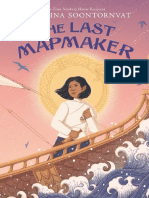


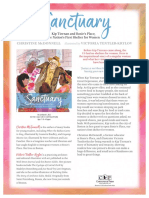
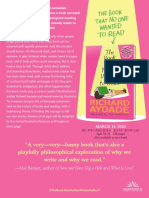



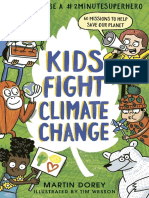

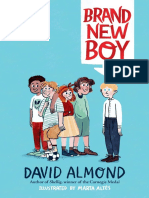






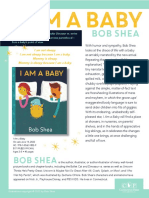
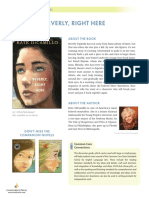





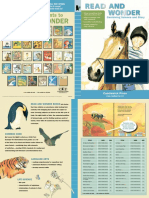





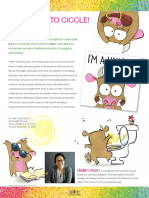

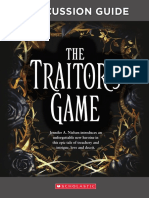






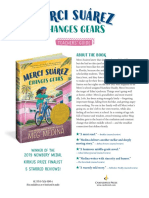
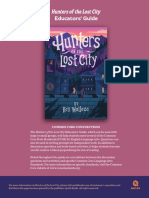



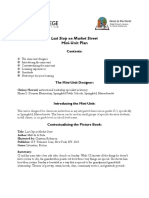









![[Children’s Literature and Culture] Justyna Deszcz-Tryhubczak and Irena Barbara Kalla - Rulers of Literary Playgrounds _ Politics of Intergenerational Play in Children’s Literature (2021, Routledge) - libgen.li](https://imgv2-2-f.scribdassets.com/img/document/586447255/149x198/b7cd36eac6/1710545898?v=1)






